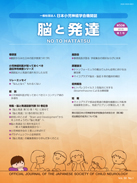
- |<
- <
- 1
- >
- >|
-
Yasuhiro Takeshima2021 Volume 53 Issue 3 Pages 170
Published: 2021
Released on J-STAGE: June 12, 2021
JOURNAL FREE ACCESSDownload PDF (168K)
-
Masayuki Sasaki2021 Volume 53 Issue 3 Pages 173-178
Published: 2021
Released on J-STAGE: June 12, 2021
JOURNAL FREE ACCESS
-
Kenjiro Kikuchi, Yoshihiro Maegaki2021 Volume 53 Issue 3 Pages 179-182
Published: 2021
Released on J-STAGE: June 12, 2021
JOURNAL FREE ACCESSDownload PDF (374K)
-
Seigo Korematsu, Yasuhiro Takeshima2021 Volume 53 Issue 3 Pages 183-185
Published: 2021
Released on J-STAGE: June 12, 2021
JOURNAL FREE ACCESSDownload PDF (382K)
-
Masafumi Morimoto, Kazuhiro Haginoya2021 Volume 53 Issue 3 Pages 186-187
Published: 2021
Released on J-STAGE: June 12, 2021
JOURNAL FREE ACCESSDownload PDF (285K) -
Hitoshi Osaka, Kazuhiro Haginoya2021 Volume 53 Issue 3 Pages 188-190
Published: 2021
Released on J-STAGE: June 12, 2021
JOURNAL FREE ACCESSDownload PDF (355K)
-
Shigemi Kimura, Akira Yoneyama, Yushiro Yamashita2021 Volume 53 Issue 3 Pages 191-194
Published: 2021
Released on J-STAGE: June 12, 2021
JOURNAL FREE ACCESSDownload PDF (393K)
-
Eiji Nakagawa, Naoyuki Tanuma2021 Volume 53 Issue 3 Pages 195-198
Published: 2021
Released on J-STAGE: June 12, 2021
JOURNAL FREE ACCESSDownload PDF (397K)
-
Eiji Nakagawa, Harumi Yoshinaga2021 Volume 53 Issue 3 Pages 199-202
Published: 2021
Released on J-STAGE: June 12, 2021
JOURNAL FREE ACCESSDownload PDF (378K)
-
Toshiyuki Yamamoto, Katsuhiro Kobayashi2021 Volume 53 Issue 3 Pages 203-206
Published: 2021
Released on J-STAGE: June 12, 2021
JOURNAL FREE ACCESSDownload PDF (378K)
-
Hirofumi Komaki, Takanori Yamagata2021 Volume 53 Issue 3 Pages 207-210
Published: 2021
Released on J-STAGE: June 12, 2021
JOURNAL FREE ACCESSDownload PDF (404K)
-
Chika Masuda, Yoshinobu Oyazato, Tomoko Fujikawa, Junya Fujimura, Atsu ...2021 Volume 53 Issue 3 Pages 211-213
Published: 2021
Released on J-STAGE: June 12, 2021
JOURNAL FREE ACCESSAnti-glycolipid antibodies have been confirmed in approximately 50% of acute flaccid myelitis (AFM) cases and approximately 60% of GBS cases. Furthermore, in GBS, the type of anti-glycolipid antibody is associated with clinical disease type. We experienced an AFM case with multiple anti-glycolipid antibodies including confirmed anti-GM1 antibody. Although there has been no report of anti-GM1 antibody-positive AFM, the clinical findings in this case are similar to that of anti-GM1 antibody-positive GBS. This case is considered important for studying the significance of anti-glycolipid antibody in AFM and its difference from other flaccid paralysis disorders such as GBS.
View full abstractDownload PDF (717K) -
Yoshihiro Osawa, Moeko Arai, Takenori Natsume, Kyoko Takano, Tetsuhiro ...2021 Volume 53 Issue 3 Pages 214-216
Published: 2021
Released on J-STAGE: June 12, 2021
JOURNAL FREE ACCESS48,XXYY aneuploidy is a rare sex chromosome variation, and 15% of the affected individuals present with seizures. This study included a 14-year-old boy with 48,XXYY karyotype revealed by seizures. The child initially developed a generalized seizure during sleep at the age of 3. The seizures were well managed with the administration of sodium valproate until the age of 12 when the generalized tonic-clonic seizure occurred. His electroencephalogram revealed frequent absence seizures and continuous spikes and waves during sleep. A 48,XXYY karyotype was identified using G-banding. The seizures were resolved with the administration of ethosuximide and sodium valproate.
View full abstractDownload PDF (936K)
-
[in Japanese]2021 Volume 53 Issue 3 Pages 223-224
Published: 2021
Released on J-STAGE: June 12, 2021
JOURNAL FREE ACCESSDownload PDF (342K) -
[in Japanese]2021 Volume 53 Issue 3 Pages 225-226
Published: 2021
Released on J-STAGE: June 12, 2021
JOURNAL FREE ACCESSDownload PDF (291K) -
[in Japanese]2021 Volume 53 Issue 3 Pages 227-228
Published: 2021
Released on J-STAGE: June 12, 2021
JOURNAL FREE ACCESSDownload PDF (255K)
- |<
- <
- 1
- >
- >|